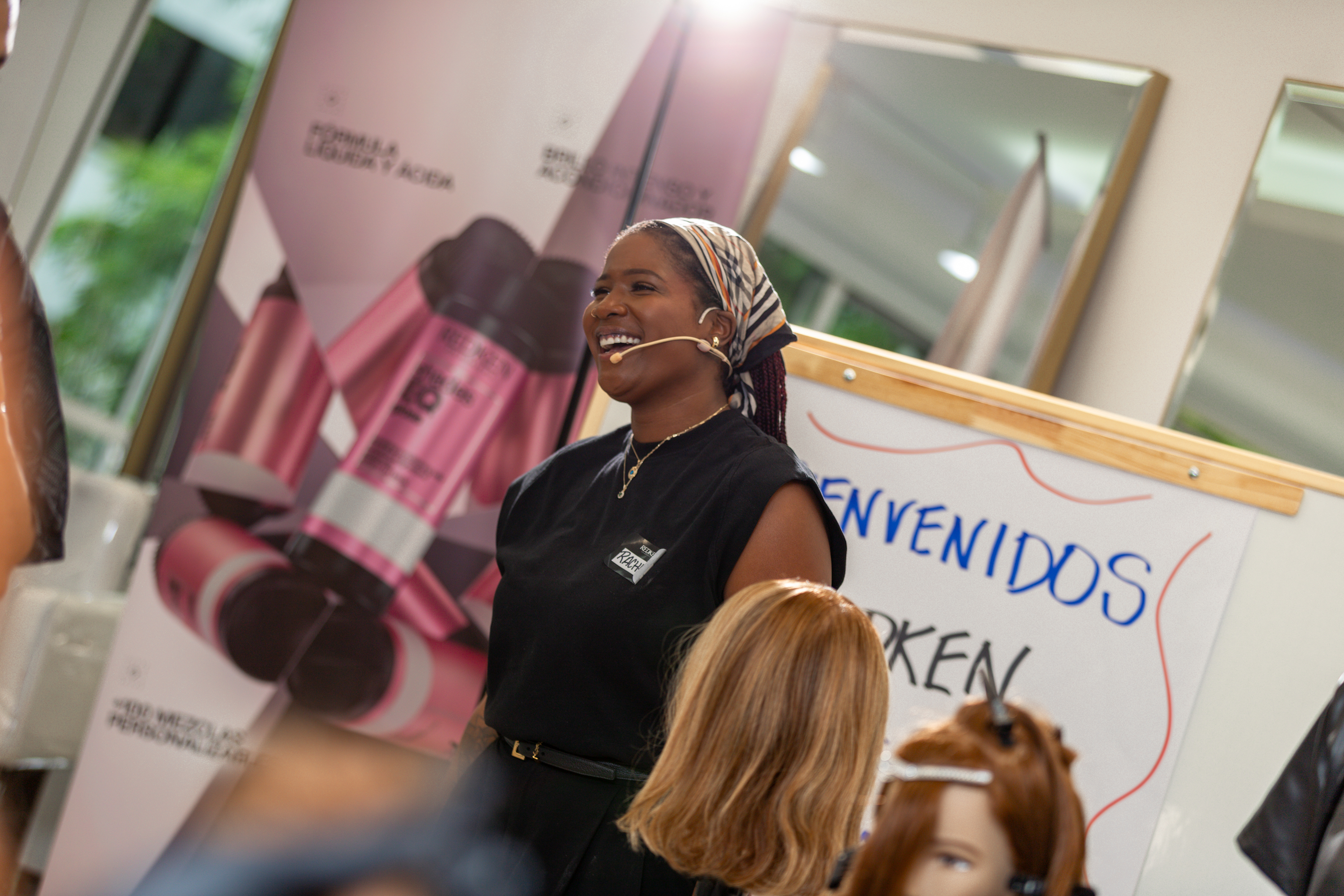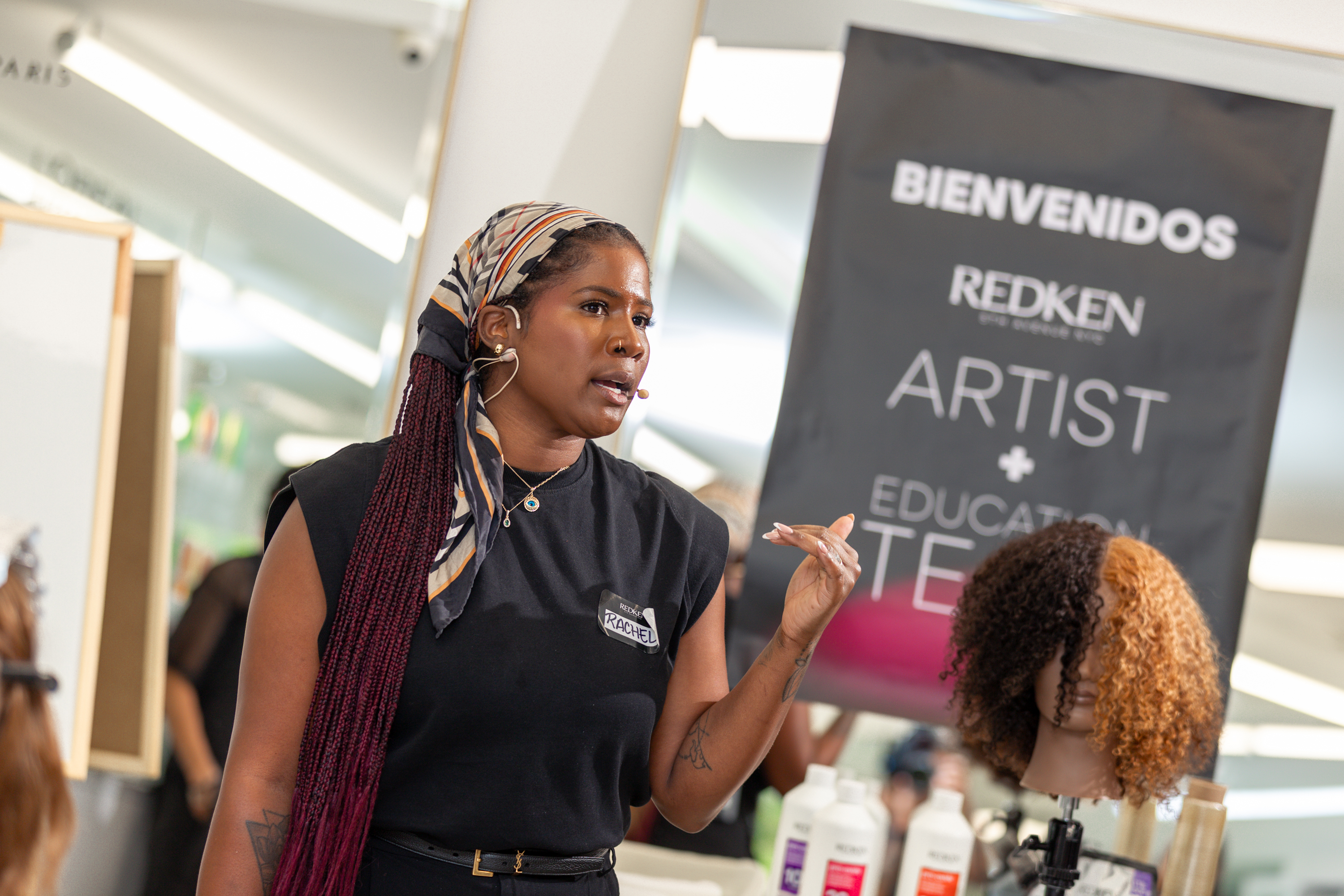Is it necessary to wash your hair with two types of shampoo? A hair care expert's recommendations for amazing hair.

“Being a woman in 2025, there is no such thing as low maintenance,” clarifies Rachel Redd, an American professional colorist with more than 17 years of experience, specializing in reddish tones and textured hair and one of the special guests at ProDimension 2025 , the second edition of the most important professional event of the year for the universe of color, styling and hair transformation in Latin America, which brought together more than 500 stylists from 11 countries for three days in Medellín, including Colombia, Peru, Ecuador, Bolivia, Paraguay, Panama, Guatemala, El Salvador, Honduras, Costa Rica and Nicaragua.
From Atlanta, Redd has revolutionized the way we color curly, afro, and straight hair, focusing on hair health and empowering other professionals through her educational workshops. Her work combines technique, creativity, and inclusion, highlighting natural beauty with boldness and style.
From the capital of Antioquia, the ambassador for brands such as Redken and Mizani spoke with EL TIEMPO about the care that must be taken into account when coloring afro and curly hair and the keys to having incredible hair, regardless of the texture.
In recent years, we've seen a greater embrace of natural hair textures, especially curly and afro hair. Why do you think this is happening? I think, first, that people who wear texture feel more comfortable with it. So they want to be able to learn and understand. They seek out professionals who previously straightened their hair and manipulated their texture to teach them how to improve it. So I think it's a bit of both: people who want to start wearing their hair and then seek out professionals who can educate them about their hair.
Does this type of hair require any special care that should be considered when subjecting it to any type of coloring? You have to consider the process. It's not even always about the texture or the curl. It's about the initial level. If you have very dark hair and you want something very light , what's the process to achieve that without damaging not only the curl shape but the overall strength of the hair strand? Understanding what will work, what's feasible for the hair to change to that degree, and how long it's going to take. And is it worth it? For example, when hair is darker, it's a little easier; it holds a little more moisture because you're not overworking it. But when you want to lighten it and take it to those blonde tones, you're putting your hair through a process that can strip away that natural oil and shine. I think you have to understand the commitment and maintenance that goes into changing your hair color to a lighter shade.

Rachel has revolutionized the way we work color on curly, afro, and straight hair. Photo: L'Oréal
It's one of those things where there are many more factors that go into hair characteristics than just texture. Your hair may be wavy. But porosity—the ability to absorb something, like moisture—doesn't always equal texture. Your hair may have a thicker texture, but it can produce oil. It doesn't necessarily mean it's drier . I like people to understand that texture is only one part of hair's characteristics and ability. I mean, just because my hair is curlier doesn't mean it's drier.
How can we recognize the type of hair we have? Of course, you have to see a professional. There's not much you can learn on YouTube because no one is licensed online. They rely on their own experience to determine what works for their hair. That's why I always recommend consulting with a specialist who can help you identify, for example, your hair texture type. Sometimes people assume that if their hair is drier, then it must be type 4C, but that's not always the case. A professional can assess the different aspects of your hair and guide you better.
This can also be analyzed based on the products you use: What type of shampoo do you use? Does it contain ingredients that strip your hair of its natural moisture? Many people, for example, use Tea Tree products because their scalp feels itchy, but they apply them all over their hair. However, what's right for the scalp isn't always right for the strands. Each product must be specific to its purpose.
It's a complex issue. You have to consider things like: what shampoo and conditioner am I using? Am I using a leave-in product that maintains moisture without drying? What climate do I live in? Is the air humid or dry? There are so many variables. The problem is that people want simple solutions, as if it were a matter of ABC. But in reality, it's the whole alphabet.
But this can be a bit overwhelming for people to include in their daily routine, could you give us three key products? Yes, it can be simplified, but without skipping key steps. For example, shampoo has a basic function: to cleanse. If you exercise frequently, use oils or hairspray, or are exposed to the environment—dust, pollen, or debris—all of this builds up in your hair. Therefore, before any treatment, you need a shampoo that clarifies and removes all that buildup. This should be followed by a second shampoo, one specifically designed to nourish or treat your hair according to its needs.
Many people notice that their hair is dry or weak and prone to breakage, indicating that it needs hydration or strengthening. So, ideally, you should have two shampoos: one that cleanses and another that provides what your hair really needs.
And what about the rest of the products? How many steps are really necessary for good hair care? After the two shampoos comes the conditioner, mask, or treatment, which helps seal in the benefits of the second wash. If the second shampoo is strengthening, then the third step should be as well. If it's moisturizing, you apply a moisturizing mask or conditioner.
But that's not all. There's a fourth step that many people forget: leave-in conditioner. It can come in a spray format, which is lighter and doesn't weigh hair down. But if you have thick, drier, or coarser hair, you can opt for a cream that better seals in moisture. And if you use heat tools like diffusers, brushes, or flat irons, it's very important that this product also includes a heat protectant. So, with a single product, you get several benefits: hydration, detangling, protection...
A good example is Redken's One United , which offers all of these in one. So, in total, we're talking four essential products. It's like makeup: you can go out with just a moisturizing tint, but then you realize you need mascara, brow gel, and lip gloss. In the end, you end up with four products. Nothing is truly low-maintenance, even if it seems that way.

Rachel focuses on hair health and empowering other professionals through educational workshops. Photo: L'Oréal
What I like about it are two things: you can have a low-maintenance style and, at the same time, look aesthetically pleasing and intentional. For example, in places where humidity is high, I wear braids, but I also have some of my natural hair exposed, which tends to frizz. In those cases, you can use a satin or silk scarf that's also pretty. You wear it like a fashion accessory. You let a little of your baby hair show, and you already have a functional and stylish look. This scarf helps protect your hair from factors like UV rays. Don't forget that your scalp is also skin and is exposed, so it's important to protect it. You can wear nice hats, like fedoras, or even visors, which are coming back in style, as long as they have a stylish touch. All of this not only protects but also adds to the look.
And then there are UV protection sprays . Many leave-in conditioners already include them. Just as we use sunscreen on our skin—or a low-SPF sunscreen if we want to get some sun exposure—the same thing happens with hair. There are products with lower SPF that help protect the scalp or highlights, especially if they're lighter and tend to lighten further in the sun. The heat of the sun can upset your hair, as if it's processing it, and if you don't have something to protect and seal it, it can become damaged.
When it comes to hair color, what can you do if you want to cover up a few gray hairs when they start to appear? You can opt for something called a "gray blend." This involves using a demi-permanent dye, which works like a gloss or color wash. This type of product doesn't lighten the hair, so it's not harsh or creates that obvious line of demarcation when the hair grows out. It blends naturally with the gray hair and adds pigment, making it reflect light, but without completely covering it.
The key is knowing what you want to achieve. If you only have a few gray hairs, you're not looking to completely cover them, but rather to soften and blend them. In that case, you don't need a full-coverage color or an overly potent product. A gloss like Redken's Shades EQ is ideal : it doesn't alter your natural color; it simply adds shine and vibrancy, while also providing a subtle tone to your gray hair.
But you also have to be realistic: like anything that involves modifying something you no longer want to see, this type of solution requires maintenance. And that's important to understand. So, as a woman in 2025, there's no such thing as low maintenance.
eltiempo




